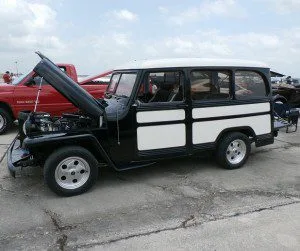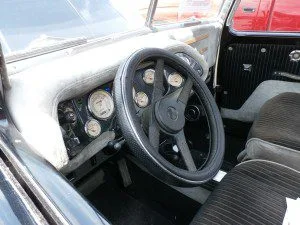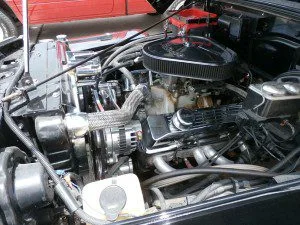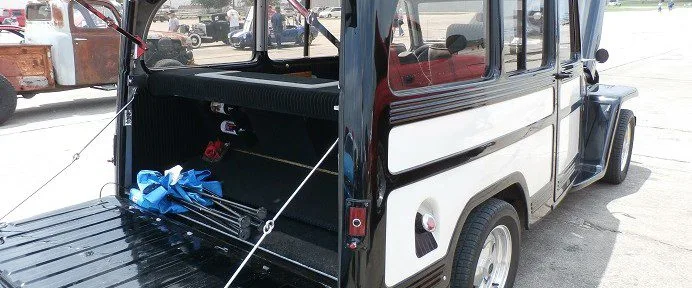Willys-Ovcerland, then Willys Jeep, produced station wagons from 1946 to 1964. It’s interesting to note that some regarded the Willys Wagon or Station Wagon as more of a truck than a car. The vehicle featured in this article is a finely restored 1951 Willys Station Wagon.

The Willys Station Wagon was introduced by Willys-Overland in 1946, the same year in which it introduced the Universal CJ Series. The CJ Series was the Jeep built for civilian use.
The Jeep Station Wagon Design
The Willys Wagon, also called Station Wagon, has the distinction of being the first all steel station wagon by at least three years. It was also the first all steel mass produced station wagon. The all steel construction made production a bit easier. The design was unique, not only the all steel construction but also because the Willys Wagon had a front end that resembled the wartime military jeep.
The Willys Jeep Station Wagon was designed by Brooks Stevens. In 1944 Stevens and others formed the Industrial Designers Society of America. Brooks Stevens not only designed automobiles but also kitchen appliances, architecture and even the Miller Brewing logo.
The Willys Station Wagon could carry seven people. The vehicle was given the nickname by some, including James D. Mooney, president and board chairman of Willys-Overland Motors, as “The Peoples Car”. The vehicle also gained a reputation as a safe vehicle that was relatively easy to maintain. Some referred to the Willys Station Wagon as a Jeep of another name.

The Willys Wagons had inline four cylinder engines through 1947 but upgraded to an inline six beginning with the 1948 model year. In general, it could be said that the Willlys Wagons were underpowered considering their weight and size.
Changes of Ownership
Willys went through several ownership changes during the 1950’s and 1960’s. In 1963 the company was called the Kaiser-Jeep Corporation. In 1970 the company was then sold to the American Motors Corporation. Willys eventually moved from the United States to Brazil, where it was engaged in the production of jeeps until 1983. Jeep finally ended up being a part of the Chrysler Corporation where it resides today and of course is quite popular.
1951 Willys Station Wagon Specifications
Just as in previous years, the Willys station wagon had a selection of different engines for the 1952 model year. These included an F6-161 Hurricane and an F 4-134 Hurricane. The F 4-134’s were also used with the Jeep CJ series. The Hurricane engine had it’s beginnings back with the Go-Devil Flathead engine.
 Transmissions available were three and four speed manuals.
Transmissions available were three and four speed manuals.
Brakes were four wheel drum.
Dimensions included an overall length of 176.3 inches and a wheelbase of 104.0 inches. The 1952 Willys Wagon weighed 2,900 lbs.
See the Auto Museum Online articles on the links below…
Classic Military Vehicles / Specs and Photos
VIN’s and Serial Numbers / What They Tell Us
1950 Chevy 3100 Half Ton Pickup
Willys Station Wagons as Collector Cars
Willys has several models that have gained popularity among car collectors. The Jeeps of course have a solid following and strict passenger cars were a part of Willys’ past. The Willys Station Wagons such as the one featured in this article has gained collector popularity as years passed.

Willys Wagons over their long production run came in a variety of styles. The older wagons such as those of the early 50’s have been rising in value. For the collector, the trick has been finding one that hasn’t been mauled. Finding originality is the challenge. Like most other collectible vehicles, the more original and the more restored Willys Station Wagons will fetch the higher price.
For some sample values, as of this writing we see a 53 Willys Utility Wagon, excellent condition and rust free, priced at $23,500. Also, a 1952 fully restored in show condition for $36,000 and a restored 1951 model with a $24,900 asking price.
(Article and photos copyright 2015 Auto Museum Online)
